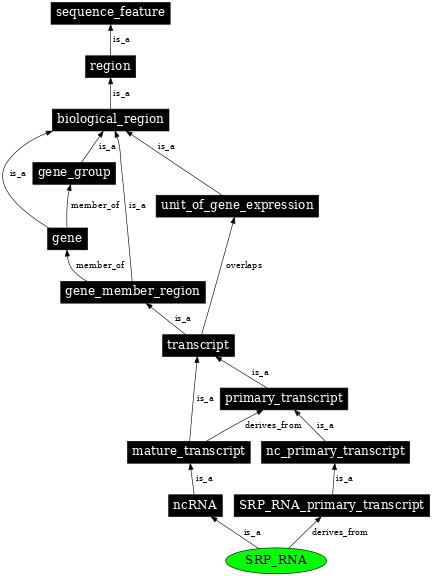SRP_RNA (CURRENT_SVN) |
|
|---|---|
| SO Accession: | SO:0000590 (SOWiki) |
| Definition: | The signal recognition particle (SRP) is a universally conserved ribonucleoprotein. It is involved in the co-translational targeting of proteins to membranes. The eukaryotic SRP consists of a 300-nucleotide 7S RNA and six proteins: SRPs 72, 68, 54, 19, 14, and 9. Archaeal SRP consists of a 7S RNA and homologues of the eukaryotic SRP19 and SRP54 proteins. In most eubacteria, the SRP consists of a 4.5S RNA and the Ffh protein (a homologue of the eukaryotic SRP54 protein). Eukaryotic and archaeal 7S RNAs have very similar secondary structures, with eight helical elements. These fold into the Alu and S domains, separated by a long linker region. Eubacterial SRP is generally a simpler structure, with the M domain of Ffh bound to a region of the 4.5S RNA that corresponds to helix 8 of the eukaryotic and archaeal SRP S domain. Some Gram-positive bacteria (e.g. Bacillus subtilis), however, have a larger SRP RNA that also has an Alu domain. The Alu domain is thought to mediate the peptide chain elongation retardation function of the SRP. The universally conserved helix which interacts with the SRP54/Ffh M domain mediates signal sequence recognition. In eukaryotes and archaea, the SRP19-helix 6 complex is thought to be involved in SRP assembly and stabilizes helix 8 for SRP54 binding. |
| Synonyms: | 7S RNA, signal recognition particle RNA, INSDC_qualifier:SRP_RNA, SRP RNA, INSDC_feature:ncRNA |
| DB Xrefs: | URL: http://www.sanger.ac.uk/cgi-bin/Rfam/getacc?RF00017 |
| Parents: | ncRNA (SO:0000655) |
| SRP_RNA_primary_transcript (SO:0000589) | |
In the image below graph nodes link to the appropriate terms. Clicking the image background will toggle the image between large and small formats.

